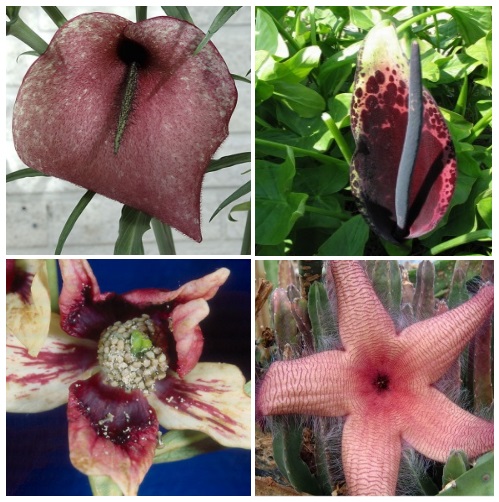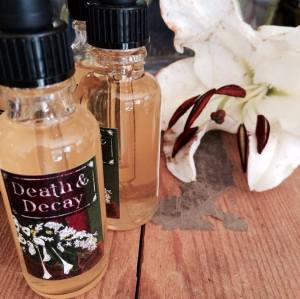POST SUMMARY: Flowers which symbolise death (and sex), huge penis-shaped flowers which reek of putrefying flesh and how YOU can smell like decomposition without the hassle of travelling to Sumatra. Read on for more…
Symbolism:
Flowers usually mean love, romance and sex: the Victorian “language of flowers” enabled young courting couples to communicate with each other without actually verbalising their thoughts. According to The Language of Flowers, a coral rose meant ‘desire’ and a red poppy meant ‘pleasure’. Orchids have long represented genitalia since they often look like female vulvae yet their name from the Greek ‘orchis’ meaning ‘testicle’ was given due to their scrotum-shaped root bulb.
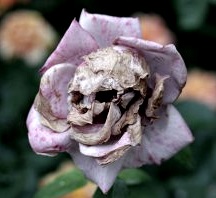
Flowers also mean death and for many this includes the orchid, particularly the ‘black orchid’ species. Similarly Lilies are synonymous with funerals. They don’t necessarily symbolise death however – rather purity and restored innocence of the soul at death. Folklore tells us lilies would spontaneously grow on the graves of those executed for crimes they were innocent of. The fact lilies were said to have bloomed when Jesus’s sweat drops fell to the ground in Gethsemane means they’re used at Easter in churches and signify not only purity but resurrection. In fact, images of Christ crucified on a ‘lily crucifix’ or holding a lily are found in many Anglican Churches in England. Lilies are also associated with the purity of the Virgin Mary whose touch is said to have turned yellow lilies white. Dreaming of lilies in winter is an omen of the death of a loved one, yet in the Medieval era this ‘death’ flower actually represented female sexuality.

Also according to The Language of Flowers, red and white roses together mean ‘unity’ but there is a different meaning for a bunch of red and white flowers and that is ‘blood and bandages’. It originated from the red and white striped barbers pole (in the UK and Europe – not the US pole which has blue stripes too) which stood outside medieval barber shops. During that time they were ‘barber-surgeons’ and performed simple surgery such as blood-letting, often with leeches, and tooth extraction. Thankfully when I go and get my hair cut nowadays my hairdresser doesn’t try to rip out my molars.
By WWI, red and white bouquets were not accepted by matrons in hospitals as they were a bad luck omen and portent of imminent death. (There are lots of interesting opinions about this here). Superstitious nurses still don’t like red and white bouquets on their wards, but with the fear of MRSA and other “super-bugs” some UK hospital wards have banned any flowers being brought in at all – yet another possible association with flowers and death.

Carrion Flowers:
However, nothing links death and flowers together like the very unusual species’ of flowers collectively called ‘carrion flowers’ or ‘corpse flowers’. Not to be confused with other stinking flowers which reek of skunks or faeces, these mostly tropical blooms smell like putrefying flesh in an attempt to attract carrion beetles, rot-loving flies and other scavenging insects to pollinate them, so perhaps NOT a bouquet to give to someone you’re romantically involved with. Unless you’re trying to break up with them. Or they are me.
**Here’s a list of 10 carrion flowers for you in case you want to put together the world’s worst bouquet**
Amorphophallus titanum (Sumatra): This probably has to be one of my new favourite flowers since it represents sex and death together. Its name comes from the Greek meaning ‘misshapen penis’ yet it reeks of putrid flesh and generates heat up to 36 degrees Celsius. Many people don’t know that decomposing corpses can be warm at first: maggot activity on flesh will actually cause it to heat up before it cools down. Therefore, when trying to estimate time of death, we have to take into account the heat of the maggot masses. This flower simulates that perfectly and is absolutely huge too (about 10ft or 3 metres tall) so NOT representative of most penises…

Helicodiceros muscivorus (Corsica, Sardinia and Balearics): This flower also called the “Dead Horse Lily” is the colour of beefsteak and also generates heat (a process known as thermogenesis) which further tricks insects – particularly blowflies – into thinking they’ve found a lovely wedge of decomposing meat.

Rafflesia arnoldii (Sumatra and Borneo): This meaty looking flower grows to be about 3 ft wide (the largest single flower of any plant) and doesn’t photosynthesize. It’s very ‘Little Shop of Horrors’ – it just grows parasitically on the Tetrastigma vine, sucking all the nutrients from that to sustain itself. It only flowers for a couple of days, however, and is becoming rare due to deforestation.

Dracunculus vulgaris (Balkans, Greece, Crete and the Aegean): This flower is also known as the ‘stink lily’ or ‘dragon lily’ and has a large purple spathe (petal) and spadix (spike). It is said to look like a dragon tongue breathing fire, hence the name. The plant can tolerate a tiny bit of shade but prefers direct sunlight and can withstand severe drought – so it’s exactly like me on holiday, as long as I have beer. It was also used to preserve cheese; the spathe of this ‘stink lily’ was wrapped around it like packaging. I have to say that’s not a cheese I’d want on my toast…
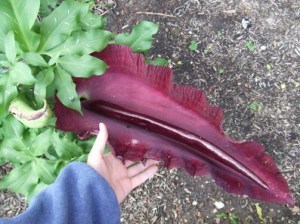
Stapelia gigantea (South Africa): These are slightly human fleshy-looking flowers which are hairy and appear as though they’re shot through with red veins. This species grows to be 12 inches (30cm across) but there are some smaller species of Stapelia, such as the lepida, which can be kept as house-plants. Most Stapelia species smell like rotten flesh. They’re related to the more glamorous Frangipani and Oleander, and you can buy them here if you dare.
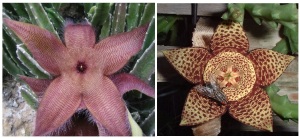
Asimina reticulata (Florida and Georgia): These are paw paw flowers – their smell is described as ‘fetid’ and they also have a similar fleshy look to some of the above examples. In a recent scientific article, these flowers are described as smelling slightly ‘yeasty’ too and GC-MS identified sulphurous and nitrogenous compounds, interesting because these are the compounds which make up the smell of putrefaction.

Crescentia alata (Mexico, Costa Rica and Central America): This flowering tree is also known as Mexican or Winged Calabash. The flowers are small and smell like carrion but they only open at night, specifically to attract nocturnal insects and even bats to cross-pollinate them. The flowers bloom directly from the trunk and look like flaps of skin.
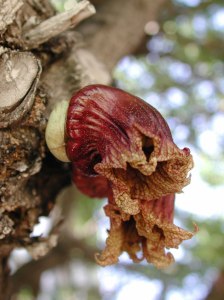
Aristolochia clematitis (Europe): Also called ‘birthwort’ or ‘Dutchman’s pipe’, this flower smells of decaying flesh and can cause damage to the kidney as well as uterine bleeding and termination of pregnancy. The flies which pollinate the plant become trapped in the hairy throat of the flower due to slippery wax granules on the inside and can’t climb out because of the dense, downward pointing hairs. In their panic, the trapped insects pollinate like crazy. It’s an all-round nasty plant which looks the picture of innocence unlike the purple, throbbing blooms above. However there are other Aristolochia spp which resemble the above, like the Aristolochia gigantea.

Arum dioscoridis (Turkey, Cyprus and Middle East): Reminiscent of advanced decomposition, these stunning blooms are popular in rock gardens and can be purchased in the UK. The putrid odour is reportedly not as bad when out in the garden but I suggest you don’t bring in a bunch to decorate the dinner table.
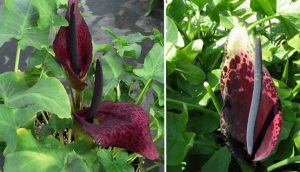
Phallus impudicus (Europe and N. America): Another very aptly named example, this one a fungus also known as a ‘stinkhorn mushroom’ and several rather naughty 17th Century monikers (e.g. “pricke mushroom” and “fungus virilis penis effigie”). Not only does it smell like rotting flesh but faeces is also hinted at to make a cocktail that most scavenging insects can’t resist. It’s not poisonous though and young mushrooms are consumed in Germany and France as they don’t stink until they’re mature. This maturing process happens incredibly fast with the rate of growth of Phallus impudicus being measured at 10-15cm per hour! So, very aptly named then…

If your budget doesn’t allow for travel to Sumatra or even the purchase of these flowers from websites then how about trying a death scent based perfume? Recently I purchased Dead Sexy by Tokyo Milk which doesn’t really smell of death but has a deep, musky odour. I really love it for autumn.
However I was recently sent this perfume, Death and Decay, by Gorilla perfume (part of Lush cosmetics) and it’s gorgeous. The manufacturers tell me it contains indole, arguably one of the best elements of any scent as it’s found in lilies which feature heavily in this perfume. (Indole is also found in jasmine and gardenia, other gloriously scented flowers). However, in higher concentrations indole is present in putrefaction. It has a heady, mammalian scent with a slightly narcotic effect which accounts for the sweetness of putrefaction (and those who’ve smelled a decomposing corpse will understand the cloying, all-encompassing nature of the aroma I mean). And before you get too freaked out by me describing corpses as sweet, bear in mind that indole is in coffee and chocolate too. I highly recommend this one, as well as ‘Cemetery’ perfume oil by Akima Botanicals, a mixture of greenery, roses and soil – like a freshly dug grave with roses on. It’s fresh, crisp and bittersweet (PS – I will be doing a video to review these perfumes properly on my YouTube channel soon)


